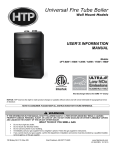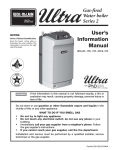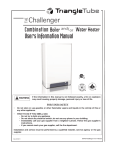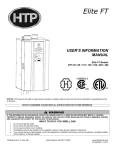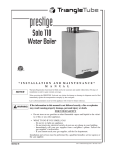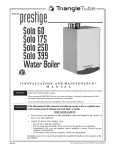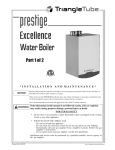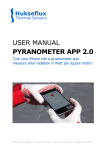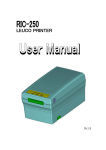Download Weil-McLain 105 Boiler User Manual
Transcript
Gas-fired water boiler Vent Supplement Ultra-80, -105, -155, -230 & -310 Installation of: • Vent piping • Air piping with This document must only be used by a qualified heating installer/service technician. Read all instructions, including this Supplement and the Boiler Manual, before installing. Perform steps in the order given. Failure to comply could result in severe personal injury, death or substantial property damage. Installation must comply with local requirements and with the National Fuel Gas Code, ANSI Z223.1 for U.S. installations or CSA B149.1 or B149.2 for Canadian installations. Part No. 550-101-235/0903 GAS-FIRED WATER BOILER — Vent Supplement Contents Please read before proceeding ........................................................ 2 Vent and air piping materials ............................................................ 3 Prepare boiler location ...................................................................... 4 Vent/air termination — through roof ................................................ 6 Vent/air termination — sidewall ........................................................ 8 Installing vent & air piping .............................................................. 11 Please read before proceeding Installer User Read all instructions before installing. Follow all instructions in proper order to prevent personal injury or death. • This document is intended only as a supplement to the Ultra Boiler Manual. It’s purpose is for the installation of vent and air piping for the boiler. • • • This document is for use only by your qualified heating installer/service technician. Please refer to the User’s Information Manual for your reference. Keep this supplement near the boiler for use by your installer or technician. All Ultra boilers must be installed as direct vent. This requires piping installation for both flue products (vent) and combustion air (air piping). All vent and air piping must be installed, terminated and sealed as described in this supplement. Failure to adhere to the guidelines in this supplement can result in severe personal injury, death or substantial property damage. Hazard definitions The following defined terms are used throughout this manual to bring attention to the presence of hazards of various risk levels or to important information concerning the life of the product. Indicates presence of hazards that will cause severe personal injury, death or substantial property damage. Indicates presence of hazards that can cause severe personal injury, death or substantial property damage. Indicates presence of hazards that will or can cause minor personal injury or property damage. Indicates special instructions on installation, operation or maintenance that are important but not related to personal injury or property damage. 2 Part number 550-101-235/0903 GAS-FIRED WATER BOILER 1 — Vent Supplement Vent and air piping materials Use only the materials listed in the table below for vent and air pipe and fittings. Failure to comply could result in severe personal injury, death or substantial property damage. Installation must comply with local requirements and with the National Fuel Gas Code, ANSI Z223.1 for U.S. installations or CSA B149.1 or B149.2 for Canadian installations. Part number 550-101-235/0903 3 GAS-FIRED WATER BOILER 2 — Vent Supplement Prepare boiler location Removing from existing vent Do not install the Ultra into a common vent with any other appliance. This will cause flue gas spillage or appliance malfunction, resulting in possible severe personal injury, death or substantial property damage. Failure to follow all instructions can result in flue gas spillage and carbon monoxide emissions, causing severe personal injury or death. Any improper operation of common venting system should be corrected so the installation conforms with the National Fuel Gas Code, ANSI Z223.1 — latest edition. Correct by resizing to approach the minimum size as determined using the appropriate tables in Part 11 of that code. Canadian installations must comply with B149.1 or B149.2 Installation Code. Vent and air piping Vent and air system When removing existing boiler from existing common vent system: At the time of removal of an existing boiler, the following steps shall be followed with each appliance remaining connected to the common venting system placed in operation, while the other appliances remaining connected to the common venting system are not in operation. a. Seal any unused openings in the common venting system. b. Visually inspect the venting system for proper size and horizontal pitch and determine there is no blockage or restriction, leakage, corrosion or other deficiencies which could cause an unsafe condition. c. Test vent system — Insofar as is practical, close all building doors and windows and all doors between the space in which the appliances remaining connected to the common venting system are located and other spaces of the building. Turn on clothes dryers and any appliance not connected to the common venting system. Turn on any exhaust fans, such as range hoods and bathroom exhausts, so they will operate at maximum speed. Do not operate a summer exhaust fan. Close fireplace dampers. d. Place in operation the appliance being inspected. Follow the lighting instructions. Adjust thermostat so appliance will operate continuously. e. Test for spillage at draft hood relief opening after 5 minutes of main burner operation. Use the flame of a match or candle, or smoke from a cigarette, cigar, or pipe. f. After it has been determined that each appliance remaining connected to the common venting system properly vents when tested as outlined herein, return doors, windows, exhaust fans, fireplace dampers, and any other gas-burning appliance to their previous conditions of use. 4 Installation must comply with local requirements and with the National Fuel Gas Code, ANSI Z223.1 for U.S. installations or CSA B149.1 or B149.2 for Canadian installations. The Ultra boiler requires a special vent system, designed for pressurized venting. Ultra boilers are rated ANSI Z21.13 Category IV (pressurized vent, likely to condense in the vent). You must also install air piping from outside to the boiler air intake adapter. The resultant installation is categorized as direct vent (sealed combustion). You may use any of the vent/air piping methods covered in this supplement. Do not attempt to install the Ultra boiler using any other means. DO NOT mix components from different systems. The vent system could fail, causing leakage of flue products into the living space. Use only PVC, CPVC or ABS pipe and fittings, with primer and cement specifically designed for the material used. Vent and air piping and termination The Ultra boiler vent and air piping can be installed through the roof or through a side wall. Follow the procedures in this document for the method chosen. The maximum vent length depends on boiler size. Refer to the information in this supplement to determine acceptable vent and air piping length. Combustion air for the Ultra boiler must be ducted directly to the boiler from outside (direct vent installation). Follow all instructions in this document and the Ultra Boiler Manual to install vent and air piping. Part number 550-101-235/0903 GAS-FIRED WATER BOILER 2 — Vent Supplement Prepare boiler location Air contamination (continued) Table 1 Corrosive contaminants Pool and laundry products and common household and hobby products often contain fluorine or chlorine compounds. When these chemicals pass through the boiler, they can form strong acids. The acid can eat through the boiler wall, causing serious damage and presenting a possible threat of flue gas spillage or boiler water leakage into the building. Please read the information given in Table 1, listing contaminants and areas likely to contain them. If contaminating chemicals will be present near the location of the boiler combustion air inlet, have your installer pipe the boiler combustion air and vent to another location, per the Boiler Manual and Vent Supplement. If the boiler combustion air inlet is located in any area likely to cause air contamination, or if products which would contaminate the air cannot be removed, you must have the combustion air and vent repiped and terminated to another location. Contaminated combustion air will damage the boiler heat exchanger, resulting in possible severe personal injury, death or substantial property damage. Do not operate an Ultra boiler if the boiler combustion air inlet is located in a laundry room or pool facility, for example. These areas will always contain hazardous contaminants. To prevent the potential of severe personal injury or death, check for areas and products listed in Table 1 before installing the boiler or air inlet piping. If contaminants are found, you MUST: • Remove products permanently. — OR — • Relocate air inlet and vent terminations to other areas. Part number 550-101-235/0903 5 GAS-FIRED WATER BOILER 3 — Vent Supplement Vent/air termination — through roof Follow instructions below when determining vent location to avoid possibility of severe personal injury, death or substantial property damage. Figure 1 Vertical termination of air & vent Installation must comply with local requirements and with the National Fuel Gas Code, ANSI Z223.1 for U.S. installations or CSA B149.1 or B149.2 for Canadian installations. Determine location Locate the vent/air terminations using the following guidelines: 1. The total length of piping for vent or air must not exceed the limits given in Table 2, page 12. 2. The air piping must terminate in a down-turned 180degree return bend as shown in Figure 1. Locate the air inlet pipe no further than 2 feet from the center of the vent pipe. This placement avoids recirculation of flue products into the combustion air stream. 3. The vent piping must terminate in an up-turned coupling as shown in Figure 1. The top of the coupling must be at least 1 foot above the air intake. The air inlet pipe and vent pipe can be located in any desired position on the roof, but must always be no further than 2 feet apart and with the vent termination at least 1 foot above the air intake. 4. You must consider the surroundings when terminating the vent and air: a. Position the vent termination where vapors will not damage nearby shrubs, plants or air conditioning equipment or be objectionable. b. The flue products will form a noticeable plume as they condense in cold air. Avoid areas where the plume could obstruct window views. c. Prevailing winds could cause freezing of condensate and water/ice buildup where flue products impinge on building surfaces or plants. d. Avoid possibility of accidental contact of flue products with people or pets. e. Do not locate the terminations where wind eddies could affect performance or cause recirculation, such as inside building corners, near adjacent buildings or surfaces, window wells, stairwells, alcoves, courtyards or other recessed areas. f. Do not terminate above any door or window. Condensate can freeze, causing ice formations. g. Locate or guard vent to prevent condensate damage to exterior finishes. 5. Maintain clearances to vent termination as given below: 6 a. Vent must terminate: • At least 6 feet from adjacent walls. • No closer than 5 feet below roof overhang. • At least 7 feet above any public walkway. • At least 3 feet above any forced air intake within 10 feet. • No closer than 12 inches below or horizontally from any door or window or any other gravity air inlet. b. Air inlet must terminate at least 6" above the roof or snow line and at least 12" below the vent termination as shown in Figure 1. c. Do not terminate closer to 4 feet horizontally from any electric meter, gas meter, regulator, relief valve or other equipment. Never terminate above or below any of these within 4 feet horizontally. 6. Locate terminations so they are not likely to be damaged by foreign objects, such as stones or balls, or subject to buildup of leaves or sediment. 7. Do not connect any other appliance to the vent pipe or multiple boilers to a common vent pipe. Part number 550-101-235/0903 GAS-FIRED WATER BOILER 3 — Vent Supplement Vent/air termination — through roof (continued) Prepare roof penetrations Multiple vent/air terminations 1. Air pipe penetration: a. Cut a hole for the air pipe. Size the air pipe hole as close as desired to the air pipe outside diameter. 2. Vent pipe penetration: a. Cut a hole for the vent pipe. For either combustible or noncombustible construction, size the vent pipe hole at least 0.4" larger than the vent pipe diameter: • 4" hole for 3" PVC • 5" hole for 4" PVC b. Insert a galvanized metal thimble in the vent pipe hole. 3. Space the air and vent holes to provide the minimum spacings shown in Figure 1, page 6. 4. Follow all local codes for isolation of vent pipe when passing through floors, ceilings and roofs. 5. Provide flashing and sealing boots sized for the vent pipe and air pipe. 1. When terminating multiple Ultra boilers, terminate each vent/air connection as described in this supplement. Terminate all vent pipes at the same height and all air pipes at the same height to avoid possibility of severe personal injury, death or substantial property damage. Termination and fittings 2. Place roof penetrations to obtain minimum clearance of 12 inches between edge of air intake elbow and adjacent vent pipe of another boiler for U. S. installations (see Figure 2). For Canadian installations, provide clearances required by CSA B149.1 or B149.2 Installation Code. 3. The air inlet of an Ultra boiler is part of a direct vent connection. It is not classified as a forced air intake with regard to spacing from adjacent boiler vents. Figure 2 Through roof terminations with multiple boilers 1. Prepare the vent termination coupling and the air termination elbow (Figure 1, page 6) by inserting the bird screens provided with the boiler. Bird screens are provided for either 3-inch (Ultra-80, -105 and 155) or 4-inch (Ultra-230 and -310) fittings. a. If using 3-inch piping for an Ultra-230, cut the 4inch bird screen supplied by placing 3-inch fitting on screen and cutting around it as a template. 2. The air piping must terminate in a down-turned 180degree return bend as shown in Figure 1, page 6. Locate the air inlet pipe no further than 2 feet from the center of the vent pipe. This placement avoids recirculation of flue products into the combustion air stream. 3. The vent piping must terminate in an up-turned coupling as shown in Figure 1, page 6. The top of the coupling must be at least 1 foot above the air intake. The air inlet pipe and vent pipe can be located in any desired position on the roof, but must always be no further than 2 feet apart and with the vent termination at least 1 foot above the air intake. 4. Maintain the required dimensions of the finished termination piping as shown in Figure 1, page 6. 5. Do not extend exposed vent pipe outside of building more than shown in this document. Condensate could freeze and block vent pipe. Part number 550-101-235/0903 7 GAS-FIRED WATER BOILER 4 — Vent Supplement Vent/air termination — sidewall Follow instructions below when determining vent location to avoid possibility of severe personal injury, death or substantial property damage. Figure 3 Sidewall termination of air & vent: (Apply left illustration unless air termination ell would not provide the minimum 12 inch clearance to grade or snow line. Apply right illustration for other applications, where exit openings are too low to provide the minimum 12 inch clearance.) A gas vent extending through an exterior wall shall not terminate adjacent to the wall or below building extensions such as eaves, parapets, balconies or decks. Failure to comply could result in severe personal injury, death or substantial property damage. Installation must comply with local requirements and with the National Fuel Gas Code, ANSI Z223.1 for U.S. installations or CSA B149.1 or B149.2 for Canadian installations. Determine location Locate the vent/air terminations using the following guidelines: 1. The total length of piping for vent or air must not exceed the limits given in Table 2, page 12. 2. The air piping must terminate in a down-turned elbow as shown in Figure 3. This arrangement avoids recirculation of flue products into the combustion air stream. 3. The vent piping must terminate in an elbow pointed outward or away from the air inlet, as shown in Figure 3. Do not exceed the maximum lengths of the outside vent piping shown in Figure 3. Excessive length exposed to the outside could cause freezing of condensate in the vent pipe, resulting in potential boiler shutdown. 4. You must consider the surroundings when terminating the vent and air: a. Position the vent termination where vapors will not damage nearby shrubs, plants or air conditioning equipment or be objectionable. b. The flue products will form a noticeable plume as they condense in cold air. Avoid areas where the plume could obstruct window views. c. Prevailing winds could cause freezing of condensate and water/ice buildup where flue products impinge on building surfaces or plants. d. Avoid possibility of accidental contact of flue products with people or pets. e. Do not locate the terminations where wind eddies could affect performance or cause recirculation, such as inside building corners, near adjacent buildings or surfaces, window wells, stairwells, alcoves, courtyards or other recessed areas. 8 f. Do not terminate above any door or window. Condensate can freeze, causing ice formations. g. Locate or guard vent to prevent condensate damage to exterior finishes. 5. Maintain clearances as shown in Figures 3, 4, and 5, pages 8, 9 and 10. Also maintain the following: a. Vent must terminate: • At least 6 feet from adjacent walls. • No closer than 5 feet below roof overhang. • At least 7 feet above any public walkway. • At lease 3 feet above any forced air intake within 10 feet. • No closer than 12 inches below or horizontally from any door or window or any other gravity air inlet. b. Air inlet must terminate at least 12" above grade or snow line; at least 12" below the vent termination; and the vent pipe must not extend more than 24" vertically outside the building as shown in Figure 3. c. Do not terminate closer to 4 feet horizontally from any electric meter, gas meter, regulator, relief valve or other equipment. Never terminate above or below any of these within 4 feet horizontally. Part number 550-101-235/0903 GAS-FIRED WATER BOILER 4 — Vent Supplement Vent/air termination — sidewall (continued) Determine location (continued) Prepare wall penetrations 6. Locate terminations so they are not likely to be damaged by foreign objects, such as stones or balls, or subject to buildup of leaves or sediment. 7. Do not connect any other appliance to the vent pipe or multiple boilers to a common vent pipe. 1. Air pipe penetration: a. Cut a hole for the air pipe. Size the air pipe hole as close as desired to the air pipe outside diameter. 2. Vent pipe penetration: a. Cut a hole for the vent pipe. For either combustible or noncombustible construction, size the vent pipe hole at least 0.4" larger than the vent pipe diameter: • 4" hole for 3" PVC • 5" hole for 4" PVC b. Insert a galvanized metal thimble in the vent pipe hole as shown in Figure 6. 3. Use a sidewall termination plate as a template for correct location of hole centers. 4. Follow all local codes for isolation of vent pipe when passing through floors or walls. 5. Seal exterior openings thoroughly with exterior caulk. Figure 4 Clearance to gravity air inlets Figure 6 Figure 5 Part number 550-101-235/0903 Sidewall termination assembly Clearance to forced air inlets 9 GAS-FIRED WATER BOILER 4 — Vent Supplement Vent/air termination — sidewall Termination and fittings Figure 7 Multiple vent/air terminations (must also comply with Figure 4) Figure 8 Multiple vent/air terminations (must also comply with Figure 4) 1. Prepare the vent termination elbow and the air termination elbow (Figure 6) by inserting the bird screens provided with the boiler. Bird screens are provided for either 3-inch (Ultra-80, -105 and -155) or 4-inch (Ultra-230 and -310) fittings. a. If using 3-inch piping for an Ultra-230, cut the 4inch bird screen supplied by placing 3-inch fitting on screen and cutting around it as a template. 2. When completed, the air termination coupling must be oriented at least 12 inches below the vent termination and at least 12 inches above grade or snow line as shown in Figure 3, page 8. 3. You can orient the vent termination elbow either directly outward or 90 degrees away from the air inlet elbow as shown in Figure 3, page 8. 4. Maintain the required dimensions of the finished termination piping as shown in Figure 3, page 8. 5. Do not extend exposed vent pipe outside of building more than shown in this document. Condensate could freeze and block vent pipe. Multiple vent/air terminations 1. When terminating multiple Ultra boilers, terminate each vent/air connection as described in this supplement. All vent pipes and air inlets must terminate at the same height to avoid possibility of severe personal injury, death or substantial property damage. (continued) (Apply this method only where exit openings are too low to provide minimum 12 inch clearance above grade/snow line.) 2. Place wall penetrations to obtain minimum clearance of 12 inches between vent pipe and adjacent air inlet elbow, as shown in Figure 7 or Figure 8 for U. S. installations. For Canadian installations, provide clearances required by CSA B149.1 or B149.2 Installation Code. 3. The air inlet of an Ultra boiler is part of a direct vent connection. It is not classified as a forced air intake with regard to spacing from adjacent boiler vents. 10 Part number 550-101-235/0903 GAS-FIRED WATER BOILER 5 — Vent Supplement Installing vent & air piping Installation must comply with local requirements and with the National Fuel Gas Code, ANSI Z223.1 for U.S. installations or CSA B149.1 or B149.2 for Canadian installations. Inserting/securing vent or air pipe into boiler adapters 1. Clean and chamfer insertion end of pipe. Deburr inside of insertion end. Clean and deburr inside and outside of other end of pipe. The pipe end must be smooth and chamfered to prevent possible damage to sealing gasket in vent or air pipe adapter. Failure to comply could result in leakage, causing possible severe personal injury or death. 2. Inspect vent or air adapter (above) — verify no obstructions or foreign objects inside. 3. Loosen clamp screw. 4. Measure 3½ inches from end of pipe and make a mark with felt-tip pen. 5. Loosen adapter clamp screw. 6. Apply small amount of silicon grease to end of pipe to ease insertion. 7. Insert pipe into adapter. 8. Slide pipe down until the 3½-inch mark is reached. Do not apply excessive force or bend the adapter or flue/air pipe when inserting. The adapter or seal could be damaged. 9. Secure vent or air pipe by tightening the adapter clamp securely. Do not overtighten. The seal is accomplished with the internal gasket. The clamp is only to hold the pipe in place. Part number 550-101-235/0903 Installing vent or air piping For reference in following see: • Sidewall termination — Figure 9, page 12. • Through-roof termination — Figure 10, page 12. 1. Work from the boiler to vent or air termination. Do not exceed the lengths given in Table 2 for either the air or vent piping. a. Note that the Ultra-230 may be installed with either 3-inch or 4-inch vent and air piping. Table 2 provides shorter allowable piping lengths when using 3-inch piping. 2. Cut pipe to required lengths. 3. Deburr inside and outside of pipe ends. 4. Chamfer outside of each pipe end to ensure even cement distribution when joining. 5. Clean all pipe ends and fittings. Dry thoroughly. 6. Dry assemble entire vent or air piping to ensure proper fit before assembling any joint. 7. For each joint: a. Handle fittings and pipes carefully to prevent contamination of surfaces. b. Apply primer liberally to both joint surfaces — pipe end and fitting socket. c. While primer is still damp, lightly apply approved cement to both surfaces in a uniform coating. d. Apply a second coat to both surfaces. Avoid using too much cement on sockets to prevent cement buildup inside. e. With cement still wet, insert pipe into fitting, twisting ¼ turn. Make sure pipe is fully inserted. f. Wipe excess cement from joint. Check joint to be sure a smooth bead of cement shows around the entire joint. 8. Install perforated metal pipe supports or equivalent as shown in Figures 9 and 10, page 12. 9. Slope vent and air piping continuously toward boiler, with at least ¼ inch drop per foot of run. Do not allow sags at any point. 10. Maintain minimum clearance of 0.2 inch between vent pipe and any combustible wall or material. Seal wall or floor penetration openings following local code requirements. 11. Use exhaust terminal plates on inside and outside walls at sidewall terminations. 11 GAS-FIRED WATER BOILER 5 — Vent Supplement Installing vent & air piping Table 2 Min/max lengths of either air piping or vent piping Figure 9 Piping to sidewall terminations (continued) Figure 10 Piping to through-roof terminations When a large number of elbows is needed with 3-inch piping, use long radius elbows to reduce pressure drop. This allows a longer run of piping. See Table 2 notes for details. Do not insulate vent piping. Exception: Where vent pipes pass through unheated spaces, such as crawl spaces or unheated garages, apply ½ inch fiberglass insulation to the portion of the vent pipe in the unheated space only. 12 Part number 550-101-235/0903












